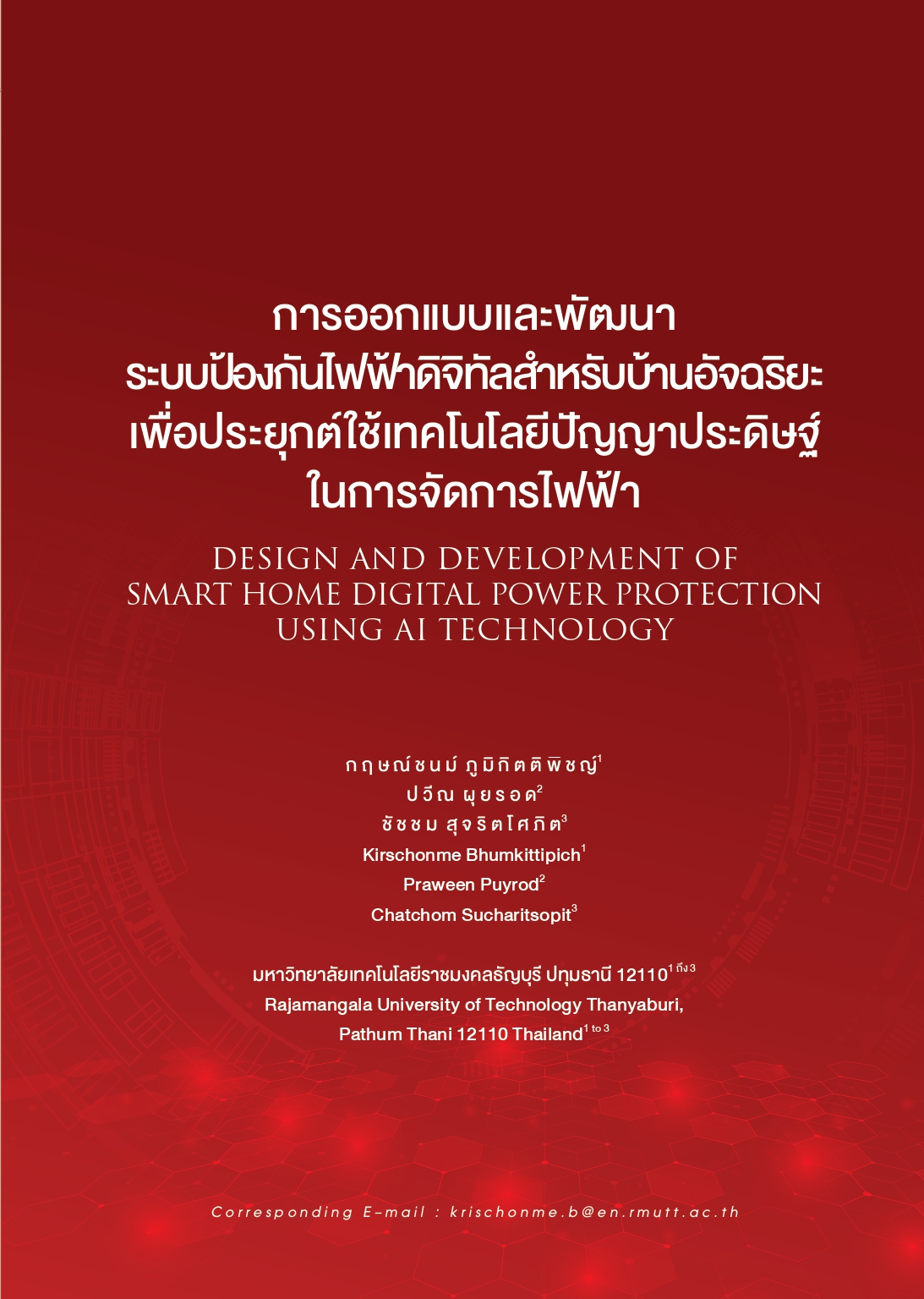Design and Development of Smart Home Digital Power Protection Using AI Technology
Keywords:
circuit breaker, intelligent circuit breaker, smart home, short circuit, fire incidentAbstract
This research is aimed to design and develop the digital electrical power protection system for smart homes to be the load center in replace of conventional circuit breakers. The study employed experimental research method conducted in conjunction with a data cloud platform. The user acceptance of the system was also studied through quantitative research methods. By installing the products in 50 households over a period of 90 days, information on electrical usage behavior and problems from actual implementation across diverse environments were gathered in order to analyze user acceptance and the commercial feasibility of the system. The users recognized the increased safety provided by the system, in particular for fire prevention caused by electric arcs from accumulating heat in electrical wires. It was found that a high level of user satisfaction was revealed at an average score of 3.85. Moreover, when employing the electrical power protection system for electrical wave analysis, positive feedback was received from the users. The system performed effectively in ensuring electrical safety and promptly sending alerts in anomalous cases.
References
บุญชม ศรีสะอาด. (2542). วิธีการทางสถิติสำหรับการวิจัย (พิมพ์ครั้งที่ 2). กรุงเทพฯ: สุวีริยาสาส์น.
สำนักป้องกันและบรรเทาสาธารณภัยกรุงเทพมหานคร. (2564). รายงานการประชุมแนวโน้มปัญหาและสาเหตุการเกิดอัคคีภัยในพื้นที่กรุงเทพมหานคร. กรุงเทพมหานคร.
สำนักงานสถิติแห่งชาติ. (2561). รายงานโครงการสำมะโนประชากรและเคหะ ปี 2561 สำนักงานสถิติแห่งชาติ กระทรวงดิจิทัลเพื่อเศรษฐกิจและสังคม. กรุงเทพมหานคร.
European Innvation Scoreboard. (2006). Comparative analysis of innovation performance. https://www.eng.auth.gr/paratiritirio/doc/2007%20EU%20Statistics/EIS2006_final.pdf
ADT Commercial. (2021). Smart Home. Protection 1 Home Security Company. https://www.protection1.com/smart-home/
Ahmed, E., Yaqoob, I., Gani, A., Imran, M., & Guizani, M. (2016). Internet of things based smart environments: state of the art, taxonomy, and open research challenges. IEEE Wireless Communications, 23(5), 10-16.
Bakar, U., Ghayvat, H., Hasanm, S., & Mukhopadhyay, S. (2016). Activity and anomaly detection in smart home: a survey. Next Generation Sensors and Systems, 191-220.
Jiang, N., Schmidt, C., Matossian, V., & Parashar, M. (2004). Enabling applications in sensor-based pervasive environments. Proc. 1st Workshop on Broadband Advanced Sensor Networks. BaseNets (p. 48). ResearchGate. https://www.researchgate.net/publication/228778561_Enabling_applications_in_sensor-based_pervasive_environments
Kamtip, S., & Bhumkittipich, K. (2015). Comparison between mechanical circuit breaker and solid-state circuit breaker under abnormal conditions for low voltage systems. 18th IEEE International Conference on Electrical Machines and Systems (pp. 1091-1096). Pattaya, Thailand: IEEE. https://ieeexplore.ieee.org/document/7385200
LaFleur, W. (2013). CBEMA AND ITIC CURVES. HubSpot. https://cdn2.hubspot.net/hub/446633/file-2240606432-pdf/White_Papers/WP108.pdf?__hstc=33975870.450c23fe1fa625221810eebc74d329cb.1588345356138.1588345356138.1588345356138.1&__hssc=33975870.1.1588345356140
Pusorn, W., Srisongkram, W., Chiangchin, K., & Bhumkittipich, K. (2015). Solid State Circuit Breaker using insulated gate bipolar transistor for distribution system protection. IEEE International Electrical Engineering Congress. iEECON2014 (pp. 1-4). Chonburi, Thailand: IEEE. https://ieeexplore.ieee.org/document/6925920
Pusorn, W., Srisongkram, W., Subsingha, W., Deng-Em, S., & Boonchiam, P. (2007). Low-cost ac solid state circuit breaker. 7th IEEE International Conference on Power Electronics and Drive Systems (pp. 1724-1729). Bangkok, Thailand: IEEE. https://ieeexplore.ieee.org/document/4487941
Shi, W., Cao, J., Zhang, Q., Li, Y., & Xu, L. (2016). Edge computing: vision and challenges. IEEE Internet of Things Journal, 3(5), 637-646.
Yamane, T. (1973). Statistics: An Introductory Analysis. London: John Weather Hill.

Downloads
Published
How to Cite
Issue
Section
License
Copyright (c) 2024 Journal of Digital Communications

This work is licensed under a Creative Commons Attribution-NonCommercial-NoDerivatives 4.0 International License.
The Office of the NBTC holds the copyright of articles appearing in the journal. The Office of the NBTC allows the public or individuals to distribute, copy, or republish the work under a Creative Commons license (CC), with attribution (BY), No Derivatives (ND) and NonCommercial (NC); unless written permission is received from the Office of the NBTC.
Text, tables, and figures that appear in articles accepted for publication in this journal are personal opinion and responsibility of the author, and not binding on the NBTC and the Office of the NBTC. In case of errors, each author is solely responsible for their own article, and not concerning the NBTC and the NBTC Office in any way.


